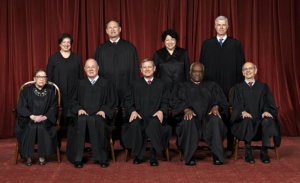 The Supreme Court receives thousands of filings. These include various types of briefs, motions, and applications. The motions and applications the Court receives may include issues such as motions to file amicus curiae briefs, motions or applications for filing date extensions, and applications for stays of orders from the lower courts. Stay applications are frequently filed alongside a petition for a writ of certiorari, seeking temporary exemption from enforcement of the order while the Court examines the merits of the case.
The Supreme Court receives thousands of filings. These include various types of briefs, motions, and applications. The motions and applications the Court receives may include issues such as motions to file amicus curiae briefs, motions or applications for filing date extensions, and applications for stays of orders from the lower courts. Stay applications are frequently filed alongside a petition for a writ of certiorari, seeking temporary exemption from enforcement of the order while the Court examines the merits of the case.
Supreme Court Rules 22 and 23 govern applications for stays. Per Rule 23, a stay may be granted by a single Justice, and any party to the judgment may file an application to stay its enforcement. Regarding the content of an application for a stay, Rule 23.3 states:
An application for a stay shall set out with particularity why the relief sought is not available from any other court or judge. Except in the most extraordinary circumstances, an application for a stay will not be entertained unless the relief requested was first sought in the appropriate court or courts below or from a judge or judges thereof. An application for a stay shall identify the judgment sought to be reviewed and have appended thereto a copy of the order and opinion, if any, and a copy of the order, if any, of the court or judge below denying the relief sought, and shall set out specific reasons why a stay is justified.
Rule 22.3 provides that an application will go to the Justice assigned to the Circuit that the case arises from. Assignments of which Justice presides over each federal circuit change with the Court’s membership. The Supreme Court’s website shows that as of May 2020, following the appointment of Justice Neil Gorsuch, the circuit assignments are as follows:
- For the District of Columbia Circuit – John G. Roberts, Jr., Chief Justice
- For the First Circuit – Stephen Breyer, Associate Justice (Maine, Massachusetts, New Hampshire, Puerto Rico, Rhode Island)
- For the Second Circuit – Ruth Bader Ginsburg, Associate Justice (Connecticut, New York, Vermont)
- For the Third Circuit – Samuel A. Alito, Jr., Associate Justice (Delaware, New Jersey, Pennsylvania, Virgin Island)
- For the Fourth Circuit – John G. Roberts, Jr., Chief Justice (Maryland, North Carolina, South Carolina, West Virginia, Virginia)
- For the Fifth Circuit – Samuel A. Alito, Jr., Associate Justice (Louisiana, Mississippi, Texas)
- For the Sixth Circuit – Sonia Sotomayor, Associate Justice (Kentucky, Michigan, Ohio, Tennessee)
- For the Seventh Circuit – Brett M. Kavanaugh, Associate Justice (Illinois, Indiana, Wisconsin)
- For the Eighth Circuit – Neil M. Gorsuch, Associate Justice (Arkansas, Iowa, Minnesota, Missouri, Nebraska, North Dakota, South Dakota)
- For the Ninth Circuit – Elena Kagan, Associate Justice (Alaska, Arizona, California, Guam, Hawaii, Idaho, Oregon, Montana, Nevada, Northern Mariana Islands, Washington)
- For the Tenth Circuit – Sonia Sotomayor, Associate Justice (Colorado, Kansas, New Mexico, Oklahoma, Utah, Wyoming)
- For the Eleventh Circuit – Clarence Thomas, Associate Justice (Alabama, Florida, Georgia)
- For the Federal Circuit – John G. Roberts, Jr., Chief Justice.
The Justice receiving the application may act alone, or may refer the application to the full Court. If the application for a stay is referred to the Court, five Justices must vote to grant the stay (compared to the four votes required to grant a petition for writ of certiorari). An interesting practice note is what’s referred to as the “courtesy fifth”: when a Justice crosses an ideological line to provide the needed fifth vote in order to maintain the status quo while the order in question is being examined.
